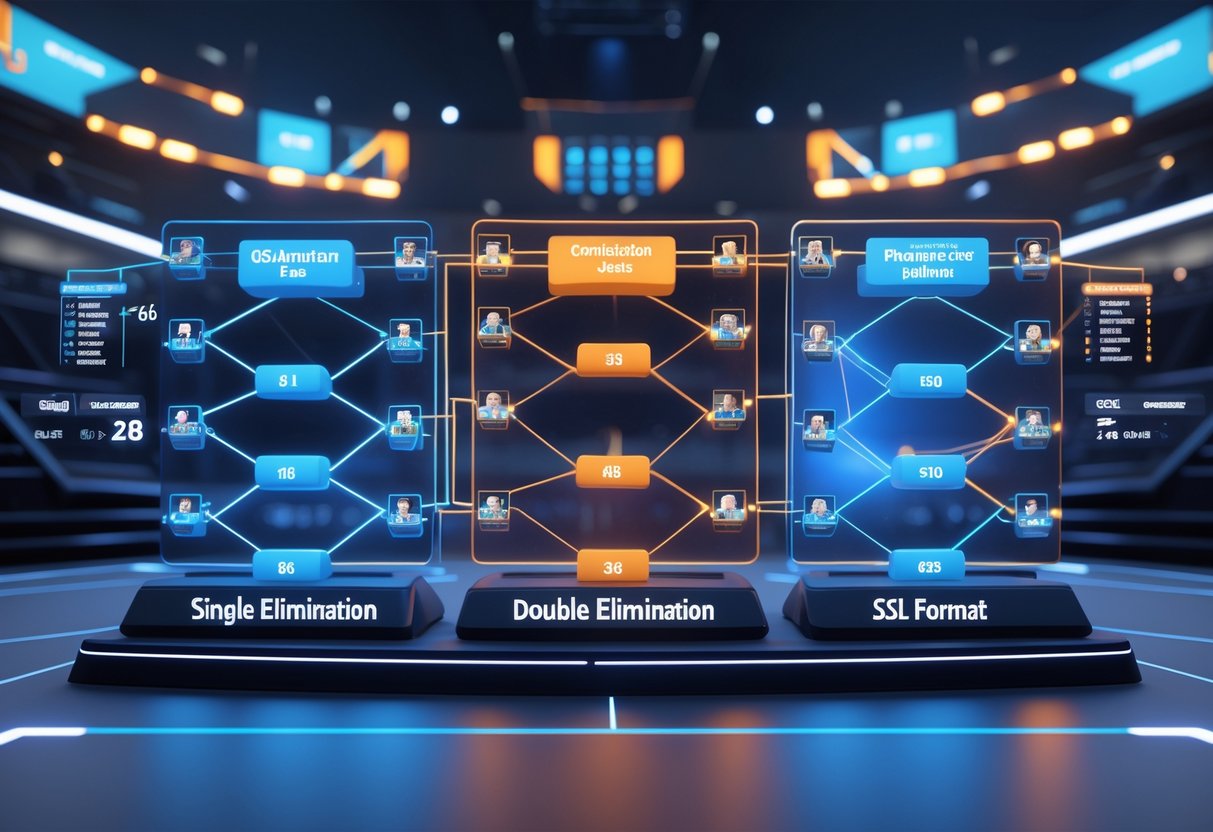GSL Format Explained: A Deep Dive into Esports Tournament Structures
Updated On: October 26, 2025 by Aaron Connolly
GSL Format Explained: Core Principles
The GSL format brings together double-elimination and group stage efficiency. Teams get three shots to qualify but only need two wins to move forward.
If a team loses twice, they’re out. This setup ramps up the stakes, as every match can decide tournament progression in a pretty lean structure.
Overview of the Dual Tournament Format
The GSL format runs as a dual tournament system, borrowing a lot from double-elimination brackets. After the first matches, teams split into winners’ and losers’ brackets.
All teams start equally in each group. The first two matches sort out who goes to the upper bracket and who drops to the lower.
This dual tournament format skips tiebreakers altogether. Unlike round-robin, teams either advance or get knocked out based on how they play.
Key advantages include:
- Faster tournament progression
- No tricky tiebreaker math
- Clear advancement paths
The format shines in group stage events where organizers need to seed teams quickly. It’s a favorite right before playoff brackets kick in.
Organizers love it because it cuts down on total matches. Each team plays up to three matches per group, which makes scheduling way more manageable.
Typical Group Stage Structure
A standard GSL group has four teams in a set bracket. The pattern is simple enough that players and viewers catch on fast.
Here’s how matches go:
- Opening matches: Teams A vs B, Teams C vs D
- Winners’ match: The opening winners face off
- Losers’ match: The opening losers battle it out
- Decider match: Winner of losers’ match vs loser of winners’ match
| Match Type | Purpose | Typical Format |
|---|---|---|
| Opening | Initial seeding | Best-of-one |
| Winners’ final | First advancement spot | Best-of-three |
| Elimination | Prevent elimination | Best-of-three |
| Decider | Second advancement spot | Best-of-three |
Group stage organizers might tweak this for different tournament sizes. Sometimes you’ll see three-team groups or even six, but the core idea stays the same.
The bracket gives every team more than one shot. Nobody goes home after just one bad match.
Win and Elimination Conditions
Teams need two match wins to get out of their group. That simple rule makes things clear for players and spectators.
If a team loses twice, they’re eliminated. It doesn’t matter how many maps they won or lost along the way.
If you win your first two matches, you qualify right away. No elimination pressure at all.
Other ways to qualify:
- Win the opener, lose the winners’ final, win the decider
- Lose the opener, win the elimination match, then win the decider
Quick win: A team that stumbles early can still make it by winning their last two matches.
Heads up: Starting slow means you can’t afford any more mistakes. Every match becomes do-or-die.
Map scores don’t matter for advancement—only match results count. Sometimes a team might win more maps overall but still get knocked out if they lose two matches.
This setup forces teams to prep for a variety of opponents. You can’t just focus on one matchup and hope for the best.
Step-by-Step Breakdown of GSL Groups
The GSL format uses double elimination with four teams and five matches to decide two advancers. Every team gets at least two shots to make it through.
First Round Matches
The group stage kicks off with two opening matches between the four teams. Usually, teams are seeded 1-4 based on rankings or past results.
Matchups typically look like this:
- Match 1: Seed 1 vs Seed 4
- Match 2: Seed 2 vs Seed 3
These openers put teams under pressure right away. You have to perform from the start or risk elimination later.
Winners move to the upper bracket and only need one more win to reach playoffs.
Losers drop to the lower bracket. Now, they have to win both remaining matches if they want to advance.
Most tournaments use best-of-one here to keep things moving. This adds a bit of chaos and makes upsets more likely.
Winner’s and Loser’s Matches
After the openers, two crucial matches decide the group’s fate. The Winner’s Match features the opening winners fighting for the first playoff spot.
Whoever wins here moves straight to playoffs as the group’s top seed. The loser drops down for one last shot.
Meanwhile, the Loser’s Match is an elimination game. The opening match losers face each other, and the loser is out for good.
The winner gets to fight again in the deciding match.
These matches usually switch to best-of-three, giving players more maps to show what they’ve got and adapt.
Deciding the Advancers
The last match decides who gets the group’s second playoff spot. The Consolidation Match pits the Winner’s Match loser against the Loser’s Match winner.
Both teams have earned their spot here. The Winner’s Match loser already beat a lower seed but couldn’t handle the group’s best.
The Loser’s Match winner bounced back after an early loss and handled elimination pressure.
This last match is usually best-of-three for fairness. The winner moves on as the group’s second seed, and the loser heads home.
The beauty of GSL is how it gives every team multiple chances. Even if a strong team slips up early, they can still claw their way back through the lower bracket.
Comparison with Other Tournament Formats

The GSL format lands somewhere between fast single-elimination brackets and long round-robin tournaments. You get more matches than a straight knockout, but way fewer than formats where everyone plays everyone.
GSL vs Round-Robin
Round-robin makes every team play each other in the group. That gives you the most accurate rankings, since everyone faces the same opponents.
Key differences:
| GSL Format | Round-Robin Format |
|---|---|
| 5 matches for 4 teams | 6 matches for 4 teams |
| 2 teams advance | Variable advancement |
| Double-elimination style | No elimination until end |
Round-robin takes longer. With four teams, you need six matches instead of five. With bigger groups, the difference gets huge—eight teams means 28 round-robin matches versus just 10 GSL matches across two groups.
GSL brings more drama. Teams are in danger after their second loss, while round-robin can have “dead rubber” matches where the result doesn’t matter.
On the flip side, round-robin seeds playoffs more fairly. Every team gets the same number of games against the same opponents.
GSL vs Double-Elimination Bracket
Double-elimination brackets share GSL’s “two lives” idea but structure matches differently. Both formats let teams survive a single bad loss.
GSL groups always have four teams and set advancement spots. Double-elimination brackets can fit any number of teams, with winners and losers moving through different brackets.
GSL is more efficient:
- GSL: 5 matches for 4 teams
- Double-elimination: 6-7 matches for 4 teams
Double-elimination brackets can be a scheduling nightmare. Sometimes, the grand final needs two matches if the lower bracket winner beats the upper bracket winner. GSL always wraps up in five matches per group.
GSL also avoids the odd situation where the “best” team loses twice to the same opponent in finals.
GSL vs Swiss-System
The Swiss-System replaced GSL as Counter-Strike’s Major format in 2017. Swiss gives teams more chances to bounce back after a rough start.
Swiss guarantees every team at least three matches before elimination. Teams move on after three wins or get knocked out after three losses. That gives more room than GSL’s cap of four matches per team.
Swiss advantages:
- More forgiving for top teams
- Handles upsets better
- Skill-based seeding develops as you go
GSL advantages:
- Faster to finish
- Easier for viewers to follow
- Simpler brackets
Swiss tournaments can drag out, and the schedule gets messy. Teams don’t know their next opponent until the round ends. GSL’s bracket is set from the start, so everyone knows what’s coming.
Lots of organizers still pick GSL for group stages before playoffs. Swiss is better for big qualifiers with tons of teams.
Origins and Evolution of the GSL Format

The GSL format started in StarCraft tournaments over twenty years ago and slowly spread across esports. What began as a practical fix for slow brackets is now a mainstay in major events.
Roots in StarCraft and Ongamenet Starleague
The GSL format showed up first in 2002 during the SKY Ongamenet Starleague qualifiers. Organizers needed a faster group stage than round-robin, but didn’t want messy tiebreakers.
The old StarCraft scene tried this “dual tournament” approach before StarCraft II arrived. It fit the fast pace of real-time strategy games perfectly.
Organizers loved:
- Fewer matches than round-robin
- No tiebreaker headaches
- Straightforward elimination
- Kept things fair
The Ongamenet Starleague showed this format could handle high-stakes play. Players had second chances, but tournaments kept moving.
Adoption by the Global StarCraft II League
The Global StarCraft II League launched in 2010 and really put the format on the map. GSL became the top StarCraft II event and made this bracket style famous.
Code S, the highest GSL tier, stuck with this structure. It worked great for StarCraft II’s skill-based matches.
The format’s success at GSL events got other esports to take notice. Fans could follow the bracket easily, and every match felt important.
StarCraft II pros liked that it rewarded consistency but still left room for upsets. Two losses and you’re out, but you could recover from early mistakes.
Expansion into Other Esports
Counter-Strike was the first big game outside StarCraft to pick up GSL. In 2012, analyst Tomi “lurppis” Kovanen talked up the format’s strengths on HLTV.org.
DreamHack Bucharest 2013 rolled out the first CS tournament with GSL. After that, DreamHack Winter 2013—the first CS Major—used it too.
Now you’ll see GSL in:
- CS: Six out of nineteen Majors in 2019
- Rainbow Six: Siege: The Six Invitational
- Dota 2: Several Majors and Minors
- StarCraft: Still going strong in GSL and WCS
League of Legends is the big exception, sticking with round-robin group stages for most major tournaments. GSL works best in games with clear match winners and shorter series, so maybe that’s why.
Popular Esports Tournaments Using GSL
You’ll find the GSL format popping up in major tournaments for all sorts of games, not just StarCraft II. It’s even become the go-to for CS Majors.
Organizers keep picking this format for high-stakes events because it creates those tense elimination matches fans love, but it also keeps the event schedule under control.
StarCraft II Tournaments
Code S is still the crown jewel for StarCraft II and sticks with the GSL format. The event runs several seasons a year and brings together 32 of the world’s best, split into groups of four.
Every group sticks to the classic GSL setup. Players need two wins to move on, or they’re out after two losses.
This leads to some wild upsets, especially when favorites get knocked out early.
The World Championship Series (WCS) also leans heavily on GSL-style groups. These feed into big finals like BlizzCon, where group results decide who makes the playoffs.
GSL just fits StarCraft II so well. Most matches run best-of-three or best-of-five, so every elimination game feels like a real do-or-die moment.
Lower-seeded players sometimes pull off surprises when they get a second chance.
Major CS and Other Events
DreamHack Winter 2013 was the first CS Major to try out GSL format. Since then, pretty much every CS Major has used some version of it for their groups.
Usually, they run best-of-one matches in the upper bracket and best-of-three for elimination. You get quick early rounds and then those pressure-packed deciders.
Rainbow Six Siege uses GSL for big events like the Six Invitational. Dota 2 works it in for various Majors and Minors too.
Just a heads-up: League of Legends almost never uses GSL. They stick with round-robin groups instead.
GSL’s popularity mostly comes from how it balances fairness and schedule control. Organizers know exactly how many matches they’ll get, so planning streams is a breeze.
Round Structure and Match Types
The GSL format gives organizers some flexibility on match length within groups. They pick between best-of-one and best-of-three depending on time or what they want competitively.
Scheduling follows a clear pattern, moving groups along efficiently while still keeping competitive integrity.
Best of One vs Best of Three
Best-of-one matches are the fastest way to run GSL groups. One game decides everything, so tournaments fly by.
Smaller events usually go with best-of-one to save time. You can finish a whole GSL group in just a few hours this way.
But there’s a downside: there’s not much room to recover. One bad map or mistake and you’re out.
Major tournaments prefer best-of-three series. Teams play up to three games, and the first to two wins takes the match.
This lets teams adapt and bounce back from a rough start. You get more strategic depth too, since teams might save special tactics for that third game.
CS Majors usually start with best-of-one for the first group matches, then switch to best-of-three for elimination and advancement. It’s a good compromise between speed and fairness.
Group Stage Scheduling
GSL groups always follow a four-match sequence. Two opening matches run at the same time, and then you get winners and losers brackets.
The winners’ match comes next—whoever wins moves straight to playoffs. After that, the elimination match pits the two initial losers against each other.
Match timing depends on the event. Smaller tournaments might run all four matches in a day, but bigger ones often spread them out to avoid burning out the viewers.
Some organizers put big-name teams in separate groups to avoid time slot clashes. That way, the top matches always get the spotlight.
GSL works well for broadcasts because every group has exactly four matches. No tiebreakers or extra games mess up the schedule.
Advancement, Elimination, and Tiebreakers

GSL almost never needs tiebreakers. Teams just need two wins to make playoffs, and nobody gets sent home without losing twice.
How Advancers Are Decided
Teams get into playoffs by winning two matches in their GSL group. It doesn’t matter which path they take.
Winners of the first two matches face off in the winners’ match. Whoever comes out on top grabs the first playoff spot from that group.
The two that lost their openers go head-to-head in the elimination match. The loser’s out, and the winner gets one more shot.
The decider match picks the second playoff spot. It’s between the loser of the winners’ match and the survivor from the elimination match.
| Match Type | Result | Next Step |
|---|---|---|
| Winners’ Match | Win | Advance to playoffs |
| Winners’ Match | Lose | Play decider match |
| Elimination Match | Win | Play decider match |
| Elimination Match | Lose | Eliminated |
| Decider Match | Win | Advance to playoffs |
| Decider Match | Lose | Eliminated |
Every team gets a real chance. Even if a strong team slips up early, they can still fight their way through the decider.
Handling Tiebreakers in GSL
Honestly, GSL almost never needs tiebreakers. Teams must win two matches to move on, so there’s no way for ties to form.
Unlike round-robin, you don’t get situations where everyone has the same record. The bracket just doesn’t allow it.
If technical issues mess up a match, organizers usually just replay the whole thing. Outcomes always come down to direct head-to-head results.
Only in rare cases, like scheduling conflicts, do organizers use map differential or seeding. But most big tournaments plan enough buffer time to avoid that.
Strengths of the GSL Format

GSL solves a bunch of problems that other formats struggle with. It cuts down on pointless matches, gives teams fair second chances, and keeps tournaments moving at a solid pace.
Minimising Dead Matches
Dead matches—where nothing’s on the line—are a real drag. Round-robin groups create a lot of these, especially late in the stage.
GSL almost wipes them out. Every match matters, since teams always have something at stake.
- Lose your first match? You have to win to stay alive.
- Win your opener? You still need another win to lock in advancement.
- Even teams that look safe often play for better seeding.
This means every game has tension. Fans stick around because the stakes never disappear.
In traditional groups, 30-40% of matches can be pointless. With GSL, it’s usually under 10%.
Balancing Excitement and Fairness
GSL gives teams two lives, but doesn’t drag things out. If you lose early, you get another shot, which feels fairer than instant elimination.
But there’s still pressure. Lose twice and you’re done.
- No one gets knocked out after just one bad game.
- Strong teams can bounce back if they stumble.
- Weaker teams can’t just coast through on luck.
Winning your first match really pays off, since your path gets easier.
This keeps things competitive. Teams know there’s a safety net, but they can’t relax.
Fast Tournament Progression
GSL groups wrap up quicker than round-robin but don’t feel as harsh as single elimination. Each group needs just 4-6 matches.
Round-robin with four teams always needs six matches. GSL can finish in four if things go to plan.
- Fewer matches overall.
- No tiebreakers to slow things down.
- Advancement rules are simple and quick.
Organizers love how efficient it is. They can run more groups in less time, without sacrificing fairness.
The format also naturally creates storylines. Teams either cruise, battle back from the brink, or crash out fast.
Viewers stay interested since every match could mean elimination.
Limitations and Critiques of GSL

GSL isn’t perfect. Critics say it can knock out strong teams too soon and doesn’t always let every team play each other. Sometimes, a bad seed or unlucky draw can ruin a favorite’s run.
Potential for Early Elimination
Teams can go home after just two matches in GSL. If you lose your opener and then the elimination match, that’s it.
It gets worse with best-of-one. One bad map or a fluke can end your tournament.
ESL One Cologne 2016 is a classic example. Three top teams (SK, Fnatic, G2) landed in the same group due to poor seeding.
Only two could advance. One world-class team went home early just because of bad group placement.
A lot of players feel this isn’t fair. Strong teams should get more chances to prove themselves.
Rematches and Their Impact
GSL sometimes forces awkward rematches. The same teams can face off twice in one group.
Say Team A beats Team B in the opener. If Team B survives the elimination and Team A loses the winners’ match, they square off again in the decider.
Fans can lose interest if they see the same matchup twice in a short span. The second game doesn’t always feel fresh.
Round-robin avoids this by making every team play each other once. Players also gripe about prepping for the same opponent twice in one stage.
Limitations Compared to Round-Robin
Round-robin lets every team play all the others in their group. You get a full ranking based on head-to-head results.
GSL doesn’t guarantee that. Team A might never meet Team C if the bracket doesn’t bring them together.
| Format | Matches per Team | Total Matches (4 teams) | Complete Rankings |
|---|---|---|---|
| GSL | 2-3 matches | 5 matches | No |
| Round-Robin | 3 matches | 6 matches | Yes |
Round-robin also protects against bad seeding. Even if all the favorites are together, they each get a fair shot based on their record.
The downside? More matches and a longer event. A lot of organizers pick GSL to save time and cut costs.
Integrating GSL Groups within Tournament Structures

GSL groups really shine as a lead-in to playoff brackets, not as standalone competitions. This format seeds teams into single or double elimination brackets, rewarding those who keep their performance up.
Seeding Playoff Brackets
GSL groups do a great job of building balanced playoff brackets thanks to their double elimination structure. Teams actually earn their spots based on how they perform, not just their starting seed.
Group winners usually grab the top seeds in playoff brackets. These squads earned it by winning both their opening match and the winners’ bracket final.
Group runners-up land in the middle seeds. They had to fight through the losers’ bracket to clinch second place.
Most tournaments stick with four-team GSL groups to fill out 8 or 16-team playoff brackets. Two groups of four each make it easy to rank teams without any tiebreaker headaches.
This seeding approach cuts out the guesswork. Organizers don’t bother with complicated points systems or making subjective calls about which team is stronger.
Combining with Single or Double Elimination
Single elimination playoffs mesh really well after GSL groups. Teams have already proven themselves in the double elimination group stage.
This setup gives teams a second chance during groups, but once playoffs begin, every match is do-or-die. One loss and you’re out.
Double elimination brackets after GSL offer a super thorough tournament structure. Teams can bounce back from losses throughout the event, which feels fairer.
Counter-Strike majors made this style popular. Groups decide the seeding, then playoffs jump into single elimination for that extra drama and clear path to the finals.
The format keeps top teams from getting knocked out too early by upsets, but it still rewards consistency. Weaker teams can move forward if they keep delivering across multiple matches.
GSL Format Variations and Modifications

Tournament organizers have tweaked the standard GSL format to fit all sorts of needs and group sizes. Most changes focus on adjusting the number of teams per group or using GSL-style brackets just for seeding.
Modifying Group Sizes
The classic GSL format feels just right with four teams per group. Still, organizers like to experiment with different sizes to suit their events.
Six-team GSL groups get a bit more complicated by adding extra opening matches. Instead of two, there are three opening games, which makes the bracket more complex but still sticks to double elimination.
Some events use three-team mini-groups when the numbers don’t add up evenly. These usually have just one opening match, and the winner goes straight to face the seeded team.
Eight-team groups break down into two four-team brackets that feed into each other. This method works for bigger tournaments, but honestly, it needs careful scheduling to avoid dragging out the group stage.
The real challenge with these bigger or smaller groups is keeping the competition fair. Larger groups can water down rivalry storylines, but smaller ones might not give enough matches to sort out who’s actually the best.
Using GSL for Seeding Purposes
A lot of tournaments now use GSL format in the group stage just to seed teams into the main bracket, not to eliminate them.
Seeding-focused GSL lets every team move on to playoffs, but it decides their bracket spots. Group upper bracket winners usually get higher seeds and better matchups in playoffs.
This tweak works especially well for double-elimination main events. Teams that struggle in groups drop to the lower bracket, while group winners start out on top.
Some organizers blend GSL seeding with Swiss system playoffs. The GSL groups set up initial Swiss rankings, creating a hybrid that balances storytelling with fair competition.
Regional qualifiers often pick this method when several teams from each region need to qualify for international play. Instead of knocking out strong teams too soon, GSL seeding keeps the best teams in the mix and the group stage interesting.
Frequently Asked Questions

The GSL format brings up some unique questions about seeding, elimination, and how it stands apart from other brackets. These questions help explain why it’s become a favorite across so many esports.
What are the primary characteristics of the GSL tournament structure?
The GSL format runs on a simple rule: win two and you move on, lose two and you’re out, all within groups of four teams. Each team gets exactly three shots to prove themselves before elimination.
Groups use a dual-tournament setup that mimics double-elimination brackets. The first two matches split teams into a winners’ bracket and a losers’ bracket.
Teams move forward by winning any two matches in their group. You can win your first two games and be done, or lose the opener and then win your next two to survive.
Usually, two teams make it out of each four-team group. Organizers sometimes change that to one or three teams, depending on how many slots they need to fill.
Can you detail how players or teams are seeded in the GSL format?
Initial seeding sticks to standard practices—higher-ranked teams get better positions. Seeding decides which teams land in the same group and where they start.
Groups usually have one top seed, one second-tier seed, and a couple of lower seeds. This setup keeps things balanced and avoids early clashes between the strongest teams.
Organizers often look at regional rankings, past tournament results, or qualifying performance to set seeds. Sometimes, they even let fans vote or consider sponsor picks for entertainment value.
Warning: Bad seeding can create those dreaded “groups of death” where several great teams knock each other out early.
How do the various stages of a GSL format event typically work?
Opening matches pair teams based on their initial seeding. Winners move to the winners’ bracket match, while losers drop to the elimination match.
Teams in the winners’ bracket just need one more win to get out of the group. Losers have to win two straight to stay alive.
The elimination match knocks out the first team from each group. The winner of that faces the loser from the winners’ bracket match in the final group decider.
Series can be best-of-one or best-of-seven, depending on how much time or prestige the tournament has.
Could you explain the difference between the GSL format and a double-elimination bracket?
GSL format keeps elimination within small groups of four teams. Double-elimination brackets cover the whole tournament in one big bracket.
In GSL, you might only play against three different teams before advancing or getting knocked out. Double-elimination lets you face way more opponents as you progress.
Quick win: GSL wraps up much faster than full double-elimination, which makes it ideal for group stages before the playoffs.
The main difference? GSL uses double-elimination logic inside groups, while traditional double-elimination applies it to the entire event.
What are the advantages of using a GSL system for esports competitions?
Tournament organizers save a ton of time compared to round-robin formats. Each group only needs six matches, not twelve like round-robin.
The format creates high-stakes matches right away since teams can get eliminated after just two losses. That makes for way more exciting viewing, compared to round-robin where some games just don’t matter.
Scheduling is easier, too. Organizers know exactly how many matches each group needs, which helps with booking venues and planning broadcasts.
Teams like having multiple chances to prove themselves—unlike single-elimination—but without the time sink of Swiss system formats.
How is the GSL format adapted for individual versus team-based competitions?
You’ll find that individual competitions basically follow the same structure as team formats. Players compete in groups of four, and if you win two matches, you move forward.
With team competitions, organizers usually go for longer series—like best-of-three or best-of-five. Teams can swap out players and tweak strategies between maps. Individual events, on the other hand, usually keep things shorter and more straightforward.
Prize distribution changes a bit depending on the format. In individual tournaments, players get prize money directly. For team events, winnings get split among the roster and sometimes the organization itself.
In practice: StarCraft II runs the GSL format for solo players. CS uses it for five-player teams, but the structural rules stay the same.

